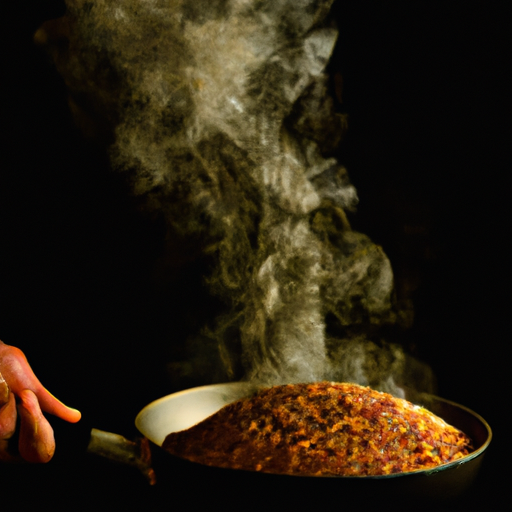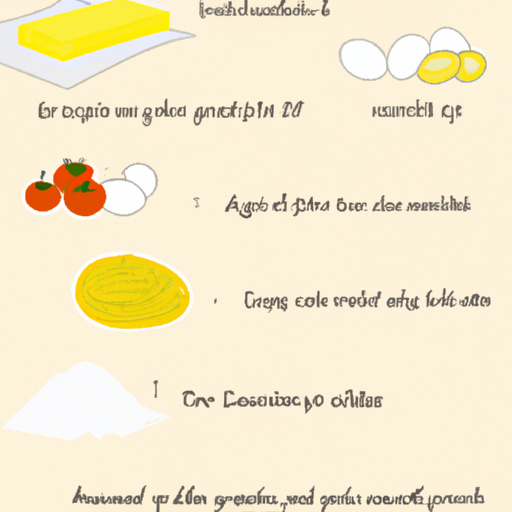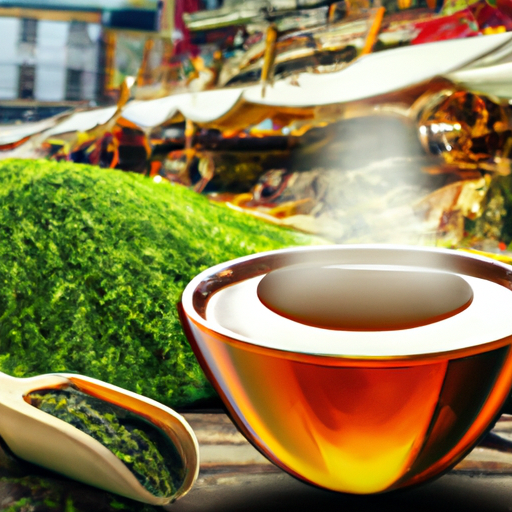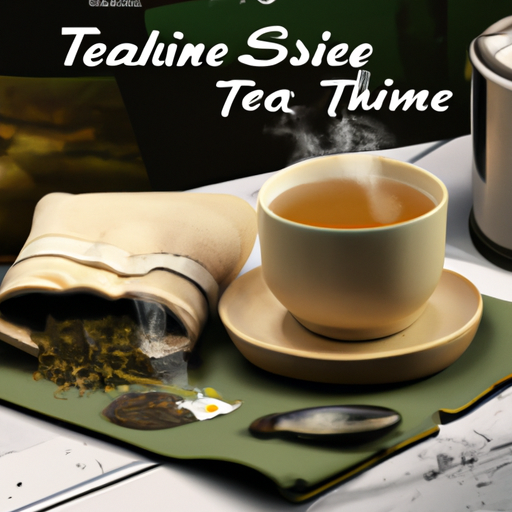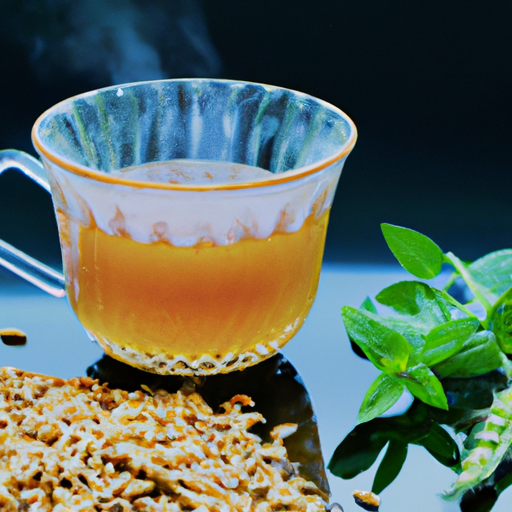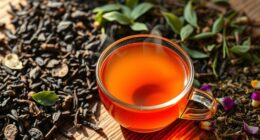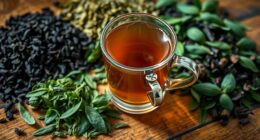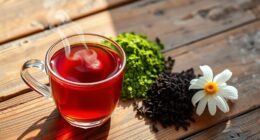Roasting barley is a key process in creating tasty and nourishing barley tea. As a tea enthusiast, I’ve discovered that roasting the barley enhances its nutty taste and fragrance, which makes the tea much more satisfying to consume.
Toasting barley at home is a simple process that requires only a few ingredients and equipment, making it a great option for anyone who wants to enjoy a warm cup of barley tea.
In this article, I will guide you through the process of toasting barley for barley tea. I will provide you with step-by-step instructions on how to toast barley in the oven and how to brew it into a delicious cup of tea.
Whether you are a tea lover or just looking for a healthy and refreshing drink, this article will provide you with all the information you need to make your own toasted barley tea at home.
So, let’s get started!
Key Takeaways
- Toasting barley brings out nutty flavor and aroma.
- Hulled barley is more nutritious, but pearl barley is more commonly found.
- Toast barley in the oven at 350°F for 20-30 minutes, stirring every 10 minutes.
- Homemade barley tea can aid digestion, improve blood sugar control, and reduce cholesterol levels.
Gather the Necessary Equipment and Ingredients
You’ll need a baking sheet, some barley, and an oven to get started. When it comes to equipment options, there are a few to choose from when toasting barley. A baking sheet is the most common choice, but you could also use a roasting pan or a cast iron skillet. Just make sure whatever you choose is oven-safe and has a flat bottom to ensure even toasting.
Next, you’ll need to choose the type of barley you want to toast. Hulled barley is the most nutritious option, as it still has its outer layer intact. However, it takes longer to cook and toast than other types of barley. Pearl barley has had its outer layer removed and is easier to find in grocery stores. It toasts quicker than hulled barley but is less nutritious. You could also try toasting other types of barley, such as black or purple barley, for a unique flavor and color.
Once you have your equipment and barley ready, preheat your oven to 350°F. This will ensure that the oven is heated to the correct temperature for toasting your barley. With your oven preheating, you’re almost ready to start toasting your barley and making delicious barley tea.
Preheat Your Oven
First, make sure the oven is preheated to the correct temperature. Preheating the oven is an essential step in toasting barley for barley tea. The benefits of preheating the oven are that it ensures even toasting and prevents the barley from burning. To preheat the oven, turn it on and set the temperature to 350°F.
Here are three ways to preheat your oven:
-
Conventional Oven: This is the most common way to preheat an oven. The oven heats up using both the top and bottom heating elements.
-
Convection Oven: This type of oven uses a fan to circulate hot air around the food. It cooks food faster and more evenly than conventional ovens.
-
Toaster Oven: A toaster oven is a smaller, more compact version of a conventional oven. It preheats faster and uses less energy than a conventional oven.
Once the oven is preheated, it’s time to spread the barley on a baking sheet. This will allow the barley to toast evenly.
Spread the Barley on a Baking Sheet
After preheating the oven, it’s time to evenly distribute the toasted barley by spreading it on a baking sheet. You can use any baking methods that you prefer, but I suggest using a thin layer to ensure even toasting. This method also allows the barley to roast evenly without getting burnt in some areas.
When spreading the barley on the baking sheet, make sure that it is not too crowded. This will prevent the grains from steaming and will ensure that they roast evenly. You can use multiple baking sheets if you need to toast a lot of barley. Just make sure that all the sheets are placed in the oven at the same time for even toasting.
Toasting barley is a great way to bring out its nutty flavor and aroma. Plus, it also has health benefits such as aiding in digestion, improving blood sugar control, and reducing cholesterol levels.
After spreading the barley on the baking sheet, it’s time to toast it in the oven. Set the oven timer for 20 to 30 minutes and make sure to stir the barley every 10 minutes for even toasting. Once done, let it cool before storing it in an airtight container.
This toasted barley can now be used to make delicious and healthy barley tea.
Toast the Barley in the Oven
Now it’s time to pop that baking sheet in the oven and let the barley toast for 20-30 minutes. Toasting the barley in the oven is one of the most popular toasting techniques for barley tea. It’s important to stir every 10 minutes to ensure even browning.
The toasting process is critical for developing the rich, nutty flavor of barley tea. Toasting the barley also enhances its flavor and aroma. The heat from the oven causes the natural oils in the barley to release, resulting in a more intense flavor.
The toasting process also removes any unwanted moisture from the barley, which helps to preserve its freshness and flavor. After 20-30 minutes of toasting, check the barley for doneness. It should be a light golden brown color and have a nutty aroma.
If the barley is not fully toasted, return it to the oven for a few more minutes. Once the barley is done toasting, remove it from the oven and let it cool completely before using it to make barley tea.
Check the Barley for Doneness
As you eagerly anticipate the perfect golden color and nutty aroma of your toasted grains, remember to keep an eye on the time to ensure that your barley is cooked to perfection. To achieve the best texture, you need to make sure that the barley is evenly toasted.
This can be done by gently shaking the baking sheet every 5 minutes to prevent any hot spots. In addition, you can also stir the grains with a spoon or spatula to ensure that all sides are evenly toasted.
When toasting barley, it’s crucial to use the right testing techniques to check for doneness. One method is to use your senses. Take a whiff of the barley to see if it has a nutty aroma. Then, use your eyes to check for the golden color. If you’re unsure, you can also taste a few grains to see if they’re crunchy and have a toasted flavor.
Another method is to use a thermometer to check the internal temperature of the barley. Once it reaches 350°F, it’s ready.
Tips for texture are crucial when toasting barley for barley tea. To achieve the desired texture, make sure to use whole barley grains and not pearled barley. Pearled barley has had its outer bran layer removed, which affects its texture and flavor.
Additionally, the toasting time will depend on the moisture content of the grains. If they’re very dry, they’ll toast faster, so keep an eye on them.
Finally, make sure to cool the barley completely before using it to make tea. This will prevent any residual heat from affecting the flavor and aroma.
Cool the Barley
To ensure the best flavor and aroma in your homemade barley tea, it’s important that you let the toasted grains cool completely before using them.
There are a few ways to cool the barley, depending on your preference and the time you have available. One method is to spread the toasted grains in a thin layer on a baking sheet and leave them at room temperature for about 30 minutes. Another option is to place the baking sheet in the fridge or freezer for a few minutes, stirring occasionally, until the barley has cooled down.
There are several benefits of using cooled barley in recipes, including barley tea. First, cooled barley is less likely to turn rancid or spoil quickly, which means you can store it for longer periods of time. Additionally, cooled barley is easier to handle and mix with other ingredients, as it won’t stick together or clump. Finally, cooled barley has a more pronounced flavor and aroma, which enhances the overall taste of the final dish.
Once the barley has cooled completely, you can store it in an airtight container until you’re ready to use it. This will help preserve the freshness and flavor of the grains, ensuring that your barley tea tastes as delicious as possible.
In the next section, we’ll discuss how to properly store your toasted barley and how long it can last in the pantry or fridge.
Store the Toasted Barley in an Airtight Container
Make sure you keep your delicious homemade barley tea fresh and flavorful by storing the toasted grains in an airtight container, so you can easily access it whenever you want to enjoy a refreshing and comforting cup.
Here are some benefits of storing your toasted barley this way:
-
Preserves Freshness: By storing your toasted barley in an airtight container, you can prevent moisture, air, and light from affecting its flavor and quality. This will keep your barley tea fresh and delicious for weeks or even months.
-
Extends Shelf Life: Toasted barley has a longer shelf life than raw barley, but it can still go stale if not stored properly. By keeping it in an airtight container, you can prolong its shelf life and avoid wasting any leftover barley.
-
Easy to Use: Storing your toasted barley in an airtight container makes it easy to measure out the amount you need for brewing your own barley tea. You won’t have to worry about the barley spilling or losing its flavor.
-
Saves Time: Instead of toasting barley every time you want to make barley tea, you can toast a larger batch and store it in an airtight container. This will save you time and effort in the long run, and you’ll always have toasted barley on hand whenever you need it.
Now that you know how to store your toasted barley, let’s move on to the next step of brewing your own barley tea.
Brew Your Own Barley Tea
First, I boil water in a pot and add the toasted barley to it. Then, I let it steep for about 10-15 minutes, stirring occasionally.
Finally, I strain the tea through a fine-mesh strainer or cheesecloth to remove any barley bits and pour it into a pitcher to cool.
Boiling Water
Simply simmer the water slowly to bring out the best flavor in your barley tea. Before you start boiling the water, it’s important to consider the quality of water you use. Using filtered water will improve the taste of your barley tea and avoid any unpleasant flavors that may come from tap water.
When it comes to choosing the right type of barley, there are various options available in the market. Pearl barley is a commonly used type, but hulled barley and roasted barley can also be used for making tea. Hulled barley is a healthier option as it retains more nutrients than pearl barley. Roasted barley, on the other hand, gives a smoky flavor to your tea.
Now that the water is boiling, it’s time to add the toasted barley.
Steeping the Toasted Barley
As you’re waiting for the toasted barley to infuse its rich flavors into the hot water, take a moment to appreciate the aroma that fills your kitchen. Once the barley has been toasted and cooled, it’s ready to be steeped in hot water.
There are a few alternative steeping methods to choose from, but the most common is to simply pour hot water over the barley and let it steep for about 10-15 minutes.
Not only does barley tea have a delicious nutty flavor, but it also has numerous health benefits. It’s rich in antioxidants, vitamins, and minerals, making it a great addition to any diet. Additionally, it’s been shown to aid in digestion, lower cholesterol levels, and even improve cardiovascular health.
As the barley continues to steep, these beneficial compounds are released into the water, creating a refreshing and healthy beverage. Moving on to the next step, we’ll need to strain the tea to remove the barley and prepare it for serving.
Straining the Tea
Now it’s time for you to strain the flavorful mixture and remove the toasted barley. Straining techniques vary, but a common method is to use a fine-mesh strainer or cheesecloth.
Simply pour the mixture through the strainer or wrap the cheesecloth around the barley and squeeze out the liquid. This will ensure a smooth and clear tea without any barley particles.
The length of time you steep the barley will affect the flavor of the tea. A longer steeping time will result in a stronger and more robust flavor, while a shorter time will produce a milder taste. You can also experiment with different types of barley for flavor variations.
Some popular options include hulled barley, pearled barley, and roasted barley. Once you’ve strained the tea, you can enjoy your delicious and healthy barley tea either hot or cold.
Enjoy Your Delicious and Healthy Barley Tea
To fully appreciate the health benefits of barley tea, it’s important to understand that it contains no caffeine, making it a great alternative to traditional teas and coffee. Did you know that drinking barley tea regularly has been linked to a reduced risk of heart disease and stroke? So not only is it delicious, but it’s also good for your heart!
When you’re ready to enjoy your barley tea, simply pour it into a cup and take a sip. You’ll immediately notice the nutty, earthy flavor that comes from the toasted barley. If you prefer a sweeter taste, you can add a little honey or sugar to your cup, or even a slice of lemon for a tangy twist.
There are many different types of barley tea flavors available, from traditional roasted barley to fruity blends that incorporate ingredients like apple, peach, or strawberry. Whatever your taste preferences, you’re sure to find a barley tea that you’ll love.
So go ahead and enjoy your delicious and healthy cup of barley tea today!
Frequently Asked Questions
What are the health benefits of drinking barley tea?
Drinking barley tea offers various health benefits that have been recognized for centuries across different cultures. Barley tea is rich in antioxidants that help in reducing inflammation, preventing chronic diseases, and improving heart health. It is also a natural diuretic that aids in flushing out toxins from the body, promoting liver and kidney health.
Barley tea recipes vary depending on the cultural significance of the drink, with some adding additional herbs or fruits to enhance the flavor. Whether enjoyed hot or cold, barley tea is a refreshing and healthy beverage that can be easily incorporated into any diet.
Can barley tea be made using a different method other than toasting the barley in the oven?
I’ve researched alternative methods for making barley tea, and it turns out that roasting in the oven isn’t the only option.
One alternative is to use a frying pan over medium-high heat. Simply add the barley to the pan and stir frequently until it turns golden brown and begins to emit a nutty aroma.
Another option is to use a popcorn maker, which can evenly roast the barley without any effort on your part. Just add the barley to the machine and let it do its job.
While toasting in the oven is the most common method, these roasting alternatives can provide a different flavor profile and add some variety to your barley tea.
How long can toasted barley be stored in an airtight container?
When it comes to storing toasted barley, it’s important to keep it in an airtight container to prevent moisture and insects from getting in. The shelf life of toasted barley can vary depending on factors such as the storage conditions and the initial quality of the barley.
Generally, toasted barley can be stored for up to six months in an airtight container at room temperature, but it’s best to use it within three months for optimal flavor and freshness. It’s also recommended to label the container with the date of toasting to keep track of its age.
If you want to extend the shelf life of toasted barley, you can store it in the freezer for up to a year. However, it’s important to note that the texture and flavor of the barley may be affected by freezing, so it’s best to use it as soon as possible after thawing.
Can the toasted barley be reused to make multiple batches of barley tea?
Oh, the joys of reusing toasted barley for multiple batches of barley tea! It’s like the gift that keeps on giving. The possibilities for flavor variations are endless!
But before we get into that, let’s address the elephant in the room: can it be done? The answer is a resounding yes! As long as the toasted barley is stored properly in an airtight container, it can be reused to make multiple batches of barley tea.
But here’s the thing, the flavor will become more subtle with each use. So, if you’re looking for a bold, robust flavor, it’s best to use fresh toasted barley for each batch. However, if you’re open to experimenting with different flavor profiles, reusing the toasted barley can be a fun and delicious way to mix things up.
Just keep track of how many times you’ve used it to ensure the flavor doesn’t become too diluted.
Is it necessary to rinse the toasted barley before using it to make barley tea?
When it comes to making barley tea, the rinsing debate is a hot topic. Some argue that rinsing the toasted barley before steeping it is unnecessary, while others insist that it’s crucial for removing any impurities and ensuring a clean, pure flavor.
Personally, I fall into the latter camp and always give my toasted barley a quick rinse before using it. As for toasting tips, I find that using a dry skillet or frying pan over medium heat works well. Just stir the barley frequently to ensure even toasting and watch for a golden brown color and nutty aroma.
Once toasted, let the barley cool completely before using it to make tea.
Conclusion
Well, that’s it, folks! We’ve successfully learned how to toast barley for barley tea.
It might seem like a small task, but the end result is a big payoff in terms of flavor and health benefits. Toasting your own barley allows you to create a custom blend of tea that fits your taste preferences.
It’s also a great way to ensure that you’re getting the freshest and highest quality ingredients possible. So go ahead and give it a try. Your taste buds and body will thank you for it!

